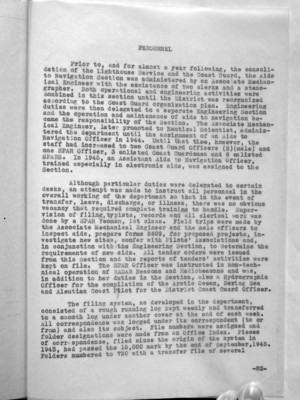Pages That Mention Assistant Aids to Navigation Officer
Coast Guard District narrative histories 1945
79
(f) Arrange for the establishment of an appropriate system whereby all users of RADAR beacons are promptly notified of outages or defects.
(g) Prepare and disseminate operating instructions for RADAR beacons.
(h) Obtain and analyze operational reports from users and from field activities in the interest of bettering the service rendered to navigators using RADAR beacons.
(i) Advise the Communications Officer as to communication facilities required.
An Assistant Aids to Navigation Officer, especially trained in electronic aids, was assigned to the District to work particularly in this field.
When the transfer of RACONS from Navy to Coast Guard was pending, the Commanding Officer of the Blimp Squadron 33 at Tillamook, Oregon, fearing the coastal RACONS might be discontinued, set forth the importance of the RACON to his command as follows: "The airship, a slow moving aircraft designed to operate in conditions of reduced visibility at a low altitude, has, when such weather conditions exist, become dependent upon the coastal RACON Stations located clear of all interference of land masses as a primary method of making a landfall...... It is often difficult to identify portions of the coast in the P. P. I. (position plot indicator) scope due to the similarity of the received images of the bays and capes of this coastline. The airships position is immediately and positively verified upon timing in the RACON signals". This gave evidence that the earlier stigma of "inefficient operation and improper maintenance" of the RACONS was being eliminated. In five months of operation, under the Coast Guard supervision, nine failures occurred but only one RACON lost actual operating time (2 hours 15 minutes) as the standby units were switched on in all other instances. The following table shows the usage of the 13th Naval District existing RACONS during the June, July and August months of 1945:
-59-
103
Prior to, and for almost a year following, the consolidation of the Lighthouse Service and the Coast Guard, the Aids to Navigation Section was administered by an Associate Mechanical Engineer with the assistance of two clerks and a stenographer. Both operational and engineering activities were combined in this section until the District was reorganized according to the Coast Guard organizational plan. Engineering duties were then delegated to a separate Engineering Section and the operation and maintenance of aids to navigation became the responsibility of the Section. The Associate Mechanical Engineer, later promoted to Nautical Scientist, administered the department until the assignment of an Aids to Navigation Officer in 1944. Until that time, however, the staff had increased to two Coast Guard Officers (R) (male) and one SPAR Officer, 3 enlisted Coast Guardsmen and 6 enlisted SPARS. in 1945, An Assistant Aids to Navigation Officer, trained especially in electronic Aids, was assigned to the Section.
Although particular duties were delegated to certain desks, an attempt was made to instruct all personnel in the overall working of the department so that in the event of transfer, leave, discharge, or illness, there was no obvious vacancy that required complete training to handle. Supervision of filing, typists, records and all clerical work was done by a SPAR Yeoman, 1st class. Field trips were made by the Associate Mechanical Engineer and the male officers to inspect aids, prepare forms 2609, for proposed projects, investigate new sites, confer with Pilots' Associations and, in conjunction with the Engineering Section, to determine the requirements of new aids. All tender orders were issued from this Section and the reports of tenders' activities were kept on file. The SPAR Officer was instructed in non-technical operation of RADAR Beacons and Radiobeacons and was, in addition to her duties in the Section, also a Hydrographic Officer for the compilation of the Arctic Ocean, Bering Sea and Aleutian Coast Pilot for the District Coast Guard Officer.
The filing system, as developed in the department, consisted of a rough running log kept weekly and transferred to a smooth log under another cover at the end of each week. All correspondence was logged under its correspondent (to or from) and also its subject. File numbers were assigned and folder designations were made from an Office Index. Pieces of correspondence, filed since the origin of the system in 1943, had passed the 15,000 mark by the end of September, 1945. Folders numbered to 730 with a transfer file of several -83

